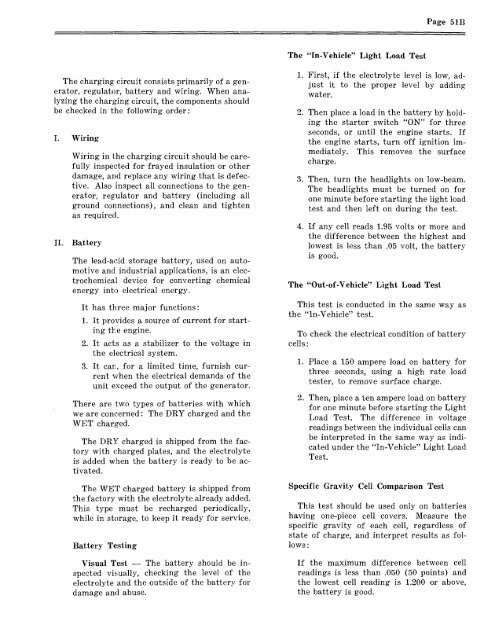Continental L-Head Overhaul Manual - Igor Chudov
Continental L-Head Overhaul Manual - Igor Chudov
Continental L-Head Overhaul Manual - Igor Chudov
You also want an ePaper? Increase the reach of your titles
YUMPU automatically turns print PDFs into web optimized ePapers that Google loves.
The charging circuit consists primarily of a generator,<br />
regulator, battery and wiring. When analyzing<br />
the charging circuit, the components should<br />
be checked in the following order:<br />
I. Wiring<br />
Wiring in the charging circuit should be carefully<br />
inspected for frayed insulation or other<br />
damage, an.d replace any wiring that is defective.<br />
Also inspect all connections to the generator,<br />
re~:ulator and battery (including all<br />
ground connections), and clean and tighten<br />
as required.<br />
II. Battery<br />
The lead-acid .storage battery, used on automotive<br />
and industrial applications, is an electrochemical<br />
device for converting chemical<br />
energy into electrical energy.<br />
It has three major functions:<br />
1. It provides a source of curren.t for starting<br />
tl~e engine.<br />
2. It acts as a stabilizer to the voltage in<br />
the electrical system.<br />
3. It car~, for a limited time, furnish current<br />
when the electrical demands of the<br />
unit exceed the output of the generator.<br />
There are ~wo types of batteries with which<br />
we are concerned: The DRY charged and the<br />
WET charged.<br />
The DRY charged is shipped from the factory<br />
with charged plates, and the electrolyte<br />
is added wlhen the battery is ready to be activated.<br />
The WET charged battery is shipped from<br />
the factory with the electrolyte already added.<br />
This type must be recharged periodically,<br />
while in storage, to keep it ready for service.<br />
Battery Testing<br />
Visual Test -- The battery should be ins,<br />
pected visually, checking the level of the<br />
electrolyte and the outside of the battery for<br />
damage and abuse.<br />
The<br />
1.<br />
"In-Vehicle" Light Load Test<br />
Page 51B<br />
First, if the electrolyte level is low, ad~<br />
just it to the proper level by adding<br />
water.<br />
Then place a load in the battery by holding<br />
the starter switch "ON" for three<br />
seconds, or until the engine starts. If<br />
the engine starts, turn off ignition immediately.<br />
This removes the surface<br />
charge.<br />
Then, turn the headlights on low-beam.<br />
The headlights must be turned on for<br />
one minute before starting the light load<br />
test and then left on during the test.<br />
If any cell reads 1.95 volts or more and<br />
the diff.erence between the highest and<br />
lowest is less than .05 volt, the battery<br />
is good.<br />
The "Out-of-Vehicle" Light Load Test<br />
This test is conducted in the same way as<br />
the "In-Vehicle" test.<br />
To check the electrical condition of battery<br />
cells :<br />
Place a 150 ampere load on battery for<br />
three seconds, using a high rate load<br />
tester, to remove surface charge.<br />
Then, place a ten ampere load on battery<br />
for one minute before starting the Light<br />
Load Test. The difference in voltage<br />
readings between the individual cells can<br />
be interpreted in the same way as indicared<br />
under the "In-Vehicle" Light Load<br />
Test.<br />
Specific Gravity Cell Comparison Test<br />
This test should be used only on batteries<br />
having one-piece cell covers. Measure the<br />
specific gravity of each cell, regardless of<br />
state of charge, and interpret results as follows<br />
:<br />
If the maximum difference between cell<br />
readings is les.s than .050 (50 points) and<br />
the lowest cell reading is 1.200 or above,<br />
the battery is good.
















